
In Norse mythology, Freyja is a goddess associated with love, beauty, fertility, sex, war, gold, and seiðr. Freyja is the owner of the necklace Brísingamen, rides a chariot pulled by two cats, is accompanied by the boar Hildisvíni, and possesses a cloak of falcon feathers. By her husband Óðr, she is the mother of two daughters, Hnoss and Gersemi. Along with her twin brother Freyr, her father Njörðr, and her mother, she is a member of the Vanir. Stemming from Old Norse Freyja, modern forms of the name include Freya, Freyia, and Freja.
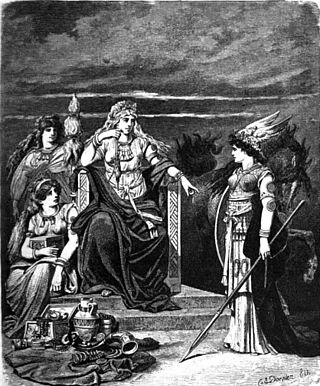
Frigg is a goddess, one of the Æsir, in Germanic mythology. In Norse mythology, the source of most surviving information about her, she is associated with marriage, prophecy, clairvoyance and motherhood, and dwells in the wetland halls of Fensalir. In wider Germanic mythology, she is known in Old High German as Frīja, in Langobardic as Frēa, in Old English as Frīg, in Old Frisian as Frīa, and in Old Saxon as Frī, all ultimately stemming from the Proto-Germanic theonym *Frijjō. Nearly all sources portray her as the wife of the god Odin.

In Norse mythology, Njörðr is a god among the Vanir. Njörðr, father of the deities Freyr and Freyja by his unnamed sister, was in an ill-fated marriage with the goddess Skaði, lives in Nóatún and is associated with the sea, seafaring, wind, fishing, wealth, and crop fertility.

In ancient Greek religion and mythology, Hestia is the virgin goddess of the hearth and the home. In myth, she is the firstborn child of the Titans Cronus and Rhea, and one of the Twelve Olympians.

In Norse mythology, Fólkvangr is a meadow or field ruled over by the goddess Freyja where half of those that die in combat go upon death, whilst the other half go to the god Odin in Valhalla. Others were also brought to Fólkvangr after their death; Egils Saga, for example, has a world-weary female character declare that she will never taste food again until she dines with Freyja. Fólkvangr is attested in the Poetic Edda, compiled in the 13th century from earlier traditional sources, and the Prose Edda, written in the 13th century by Snorri Sturluson. According to the Prose Edda, within Fólkvangr is Freyja's hall Sessrúmnir. Scholarly theories have been proposed about the implications of the location.
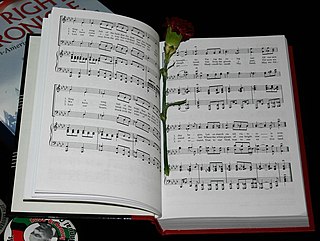
"Lift Every Voice and Sing" is a hymn with lyrics by James Weldon Johnson (1871–1938) and set to music by his brother, J. Rosamond Johnson (1873–1954). Written from the context of African Americans in the late 19th century, the hymn is a prayer of thanksgiving to God as well as a prayer for faithfulness and freedom, with imagery that evokes the biblical Exodus from slavery to the freedom of the "promised land."

A hulder is a seductive forest creature found in Scandinavian folklore. Her name derives from a root meaning "covered" or "secret". In Norwegian folklore, she is known as huldra. She is known as the skogsrå "forest spirit" or Tallemaja "pine tree Mary" in Swedish folklore, and ulda in Sámi folklore. Her name suggests that she is originally the same being as the völva divine figure Huld and the German Holda.

The Nixie, Nixy, Nix, Näcken, Nicor, Nøkk, or Nøkken are humanoid, and often shapeshifting water spirits in Germanic mythology and folklore.
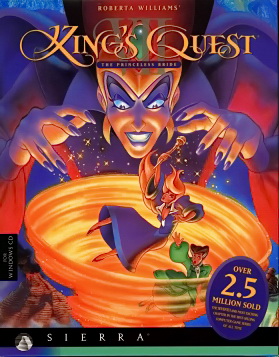
King's Quest VII: The Princeless Bride is a graphic adventure game developed and published by Sierra On-Line for the MS-DOS, Microsoft Windows and Macintosh computers in 1994. It features high-resolution graphics in a style reminiscent of Disney animated films and is the only King's Quest game with multiple protagonists: Queen Valanice and Princess Rosella, who are both spirited away to the realm of Eldritch, and Rosella is transformed into a troll. They must find a way to return Rosella to normal and find her true love, get rid of a powerful evil force threatening this realm, and get back to their kingdom Daventry.
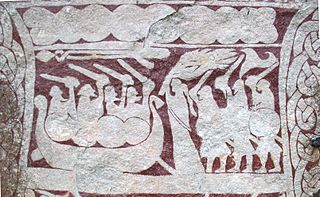
Sörla þáttr eða Heðins saga ok Högna is a short narrative from the extended version Óláfs saga Tryggvasonar en mesta found in the Flateyjarbók manuscript, which was written and compiled by two Christian priests, Jon Thordson and Magnus Thorhalson, in the late 14th century. The narrative begins 24 years after the death of Fróði, and takes place in the 9th and the 10th centuries. It is a composite tale containing a story of how Freyja acquired a necklace from the Dwarves, how that led to a bloody war, and how Olaf Tryggvason brought peace to the land.

Pamela Voorhees is a fictional character and the overarching antagonist of the Friday the 13th series of horror films. She was created by Victor Miller, and first appeared in Sean S. Cunningham's Friday the 13th (1980), played by Betsy Palmer. Pamela is the main antagonist of the first film, in which she is known only as Mrs. Voorhees, and remains an antagonistic presence in its sequels, in which she is seen mostly as a severed head or a figment of her son's imagination. In Friday the 13th Part III (1982), the character appears as a reanimated corpse in a hallucination, played by Marilyn Poucher. Paula Shaw played Pamela in the crossover Freddy vs. Jason (2003); according to Palmer in Friday The 13th Reunion, she was asked to reprise her role in the film, but turned it down after reading the script. Nana Visitor played Pamela in the 2009 reboot.

Jessica Randolph Harper is an American actress and singer. Harper began her feature film career with a starring role in Brian De Palma's Phantom of the Paradise (1974), and subsequently featured in films including Love and Death (1975), Inserts (1975) and My Favorite Year (1982). She is best known for her portrayal of Suzy Bannion, the protagonist of Dario Argento's cult classic Suspiria (1977), and appeared in a supporting role in Luca Guadagnino's 2018 remake.

Fossegrim, also known simply as the grim (Norwegian) or Strömkarlen (Swedish), is a water spirit or troll in Scandinavian folklore. Fossegrim plays the fiddle, especially the Hardanger fiddle. Fossegrim has been associated with a mill spirit (kvernknurr) and is related to the water spirit (nokken) and is sometimes also called näcken in Sweden. It is associated with river streams and particularly with cascading streams and mill races.

Hansel and Gretel is a 2002 American fantasy comedy film based on the fairy tale of the same name by Brothers Grimm. The film is directed by Gary J. Tunnicliffe and produced by Steve Austin and Jonathan Bogner. Jacob Smith and Taylor Momsen portray the eponymous characters, alongside Howie Mandel, Alana Austin, Delta Burke, Lynn Redgrave, Bobcat Goldthwait, and Sinbad. The film follows siblings Hansel and Gretel as they try to escape from the Magic Forest and a witch's gingerbread house with the help of the Sandman and the Wood Fairy. The film received negative reviews from critics.
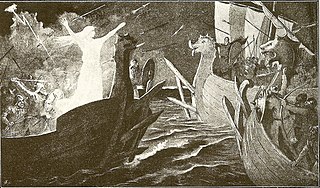
Þorgerðr Hölgabrúðr and Irpa are divine figures in Norse mythology. They appear together in Jómsvíkinga saga, Njáls saga, and Þorleifs þáttr jarlsskálds. Irpa's name does not appear outside of these four attestations, but Þorgerðr also appears in the Prose Edda book Skáldskaparmál, Færeyinga saga, and Harðar saga ok Hólmverja and is mentioned in Ketils saga hœngs.

The Captive Curse is the 24th installment in the Nancy Drew point-and-click adventure game series by Her Interactive. The game is available for play on Microsoft Windows and Mac OS X platforms. It has an ESRB rating of E10+ for moments of mild violence and peril. Players take on the first-person view of fictional amateur sleuth Nancy Drew and must solve the mystery through interrogation of suspects, solving puzzles, and discovering clues. There are two levels of gameplay, Junior and Senior detective modes, each offering a different difficulty level of puzzles and hints, however neither of these changes affect the plot of the game. The game is loosely based on the book Captive Witness (1981).

Micro is a techno-thriller novel by Michael Crichton, the seventeenth under his own name and second to be published after his death, published in 2011. Upon his death in 2008, an untitled, unfinished manuscript was found on his computer, which would become Micro. Publisher HarperCollins chose science writer Richard Preston to complete the novel from Crichton's remaining notes and research, and it was finally published in 2011. Micro followed the historical thriller Pirate Latitudes, which was also found on his computer and published posthumously in 2009.

The Skogsrå, Skogsfrun, Skogssnuvan, Skogsnymfen, Råndan or Huldran, is a mythical female creature of the forest in Swedish folklore.

The Fireman is a post-apocalyptic novel by American author Joe Hill. The novel, his fourth, tells the tale of a deadly spore that has infected most of the world's population. Hill first spoke of the novel in 2013 in promotional interviews for his then-new novel NOS4A2. The novel was released on May 17, 2016.

Bramble: The Mountain King is a 2023 action-adventure video game developed by Dimfrost Studio and published by Merge Games. Players control a young boy named Olle who attempts to rescue his kidnapped sister Lillemor from mythological creatures.



















